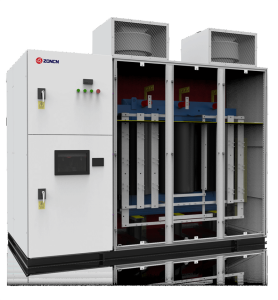Selecting a high-voltage inverter requires considering multiple factors to ensure that it can meet the specific application requirements. Here are some key steps and considerations:
First, you need to clarify the requirements
Application scenario: Determine what equipment or system the inverter will be used for, such as pumps, fans, compressors, etc.
Power requirements: Calculate the required power level, usually in kW or MW.
Voltage level: Confirm the required input and output voltages. Usually, the output voltage range of high-voltage inverters is between 3kV and 10kV.
Technical parameters and adaptability of high-voltage inverters
1. The adaptability of the inverter to the environment
The adaptability of the high-voltage inverter to the voltage fluctuation of the power grid. After the instantaneous power failure of the voltage, the inverter should have the function of continuous or recovery operation.
Most high-voltage inverters are installed near the auxiliary machines on site. Dust entering the inverter cabinet will cause insulation degradation or breakdown and damage to electronic components. Dust blocking the filter will cause poor heat dissipation of the power cabinet, which is easy to cause overheating of the power module, or even failure and damage. In the hot and humid climate areas in the south, products with low requirements for ambient temperature and humidity and relatively low system temperature rise should be selected to ensure safe and stable operation.
2. The inverter’s ability to withstand minor faults
The high-voltage inverter has a unit bypass function. That is, when a power unit fails, the unit should be able to automatically exit, and the entire system can continue to operate with the fault. This is actually a redundant design technology. When selecting a high-voltage inverter, attention should be paid to the impact of the unit bypass on the inverter’s load capacity, mainly considering the number of power units per phase of the inverter and the voltage compensation of the control system.
3. The inverter’s ability to withstand external faults
When selecting a high-voltage inverter, the inverter’s ability to withstand external faults on the input side should be considered, such as the impact of bus voltage drop caused by external grid faults on the operation of the high-voltage inverter, or the impact of cable breakdown short circuit or single-phase grounding of the motor, or even interphase short circuit faults on the high-voltage inverter. The high-voltage inverter should be equipped with a single-phase grounding fault detection function, and the alarm or trip protection should be set according to the on-site situation.
4. Fault recovery time of frequency converter
Equipment failures are divided into two types: one is the instantaneous self-recoverable fault. Once this fault occurs, it can recover in a short time. The second is the recovery time of the device after a permanent damage fault occurs. Under normal circumstances, the modularization of the power unit can be selected to replace the spare module in a short time, so that the equipment can resume operation in a short time.
5. The impact of frequency conversion transformation on motor protection
High-voltage frequency converters are generally equipped with power frequency bypass cabinets to ensure that when the frequency converter fails or is under maintenance, the switching motor of the power frequency bypass cabinet can be restored to power frequency operation to ensure continuous production.
6. Manual bypass and automatic bypass
The operation mode of manual switching frequency converter has problems such as complex operation and long interruption time that affect the stability of the unit. The frequency converter with automatic switching of power frequency conversion can automatically switch to power frequency operation when a fault occurs, ensuring the continuous operation of important auxiliary machines and reducing the impact on the unit and even the power grid. However, when the motor fails, the frequency converter automatically switches to power frequency, which will aggravate the motor failure and there is a risk of expanding the failure. In specific applications, the advantages and disadvantages of the “automatic bypass switching function” should be fully considered. It is best if the inverter control system has the ability to distinguish between its own faults and load faults.
7. Impact of harmonics on power grid and motor
The input current of low-voltage inverter has a large number of high-order harmonic components. These harmonics not only cause “harmonic pollution” to the power grid, but also reduce the power factor of the inverter input circuit. High-voltage inverters usually use multiple rectification technology to reduce harmonic pollution to the power grid and improve the power factor on the input side of the inverter.
8. Life of inverter
The life of high-voltage inverter equipment is mainly determined by electrolytic capacitors, and the life of electrolytic capacitors is directly related to their operating temperature and ripple current. For general variable loads, when the operating environment meets the design conditions, the life of electrolytic capacitors is more than 8 years, and the cost of replacing capacitors accounts for about 5% to 10% of the system investment.
By combining the above factors, choosing the most suitable high-voltage inverter can improve the efficiency and reliability of the system and reduce operating costs. It is recommended to evaluate the purchase cost of the inverter with professional technicians before purchasing, including equipment price, installation costs, etc. Choose a supplier who can provide good technical support and after-sales service. If there are special functional requirements, confirm whether the supplier can provide customized solutions.

